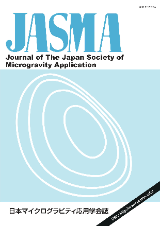All issues

Volume 20 (2003)
- Issue 4 Pages 251-
- Issue 3 Pages 151-
- Issue 2 Pages 91-
- Issue 1 Pages 1-
Volume 20, Issue 4
Thermal Engineering in Microgravity
Displaying 1-6 of 6 articles from this issue
- |<
- <
- 1
- >
- >|
-
[in Japanese]2003Volume 20Issue 4 Pages 251-
Published: October 31, 2003
Released on J-STAGE: January 21, 2021
JOURNAL OPEN ACCESSDownload PDF (372K) -
Paolo Di MARCO2003Volume 20Issue 4 Pages 252-
Published: October 31, 2003
Released on J-STAGE: January 21, 2021
JOURNAL OPEN ACCESSThe first section of this paper (overview on boiling heat transfer characteristics) is directed to those who are not specialists in the field of boiling heat transfer, in order to make them aware of the fundamental physical mechanisms,the advantages and the main problems of this technique. Next, some of the basic knowledge achieved on terrestrial boiling heat transfer is outlined, along with the benefits and the problems raised from its application in space. Finally, the past and forthcoming research activities of the European teams in this field are reported, in addition to the main results achieved and a short overview on the available test facilities.View full abstractDownload PDF (361K) -
Jung-ho KIM2003Volume 20Issue 4 Pages 264-
Published: October 31, 2003
Released on J-STAGE: January 21, 2021
JOURNAL OPEN ACCESSA brief review of recent low gravity boiling research by investigators based in the United States is performed. Topics covered include bubble dynamics, nucleate pool boiling and CHF, transition boiling, boiling of mixtures, electric field effects, acoustic field effects, and flow boiling. Planned research activities and recommendations for future research are given.View full abstractDownload PDF (313K) -
Haruhiko OHTA2003Volume 20Issue 4 Pages 272-
Published: October 31, 2003
Released on J-STAGE: January 21, 2021
JOURNAL OPEN ACCESSTo introduce the advance in the researches on boiling and two-phase flow in reduced gravity fields and the change in the situation surrounding them in Japan, a short review is focused on the individual research subjects, i.e., pool boiling, flow boiling, and unheated two-phase flow including their major topics. Representative results obtained so far are introduced. Future direction of researches on the present discipline is proposed and the activity to enhance the opportunity to use facilities with longer reduced gravity duration is explained.View full abstractDownload PDF (2201K) -
Osamu FUJITA2003Volume 20Issue 4 Pages 286-
Published: October 31, 2003
Released on J-STAGE: January 21, 2021
JOURNAL OPEN ACCESSPresent status and future prospect of microgravity combustion research in Japan and USA are introduced. Since combustion phenomenon is strongly affected by gravitational force, microgravity has been played important roles in all research areas of combustion, gaseous combustion, liquid combustion and solid combustion. In the next decade contribution to energy and environmental problem and material science through microgravity combustion research will be important as well as fundamental research for fire safety for long-term manned space missions.View full abstractDownload PDF (5420K) -
Naoki ICHIKAWA, Masaki MISAWA, Masahiro KAWAJI, George PSOFOGIANNAKIS2003Volume 20Issue 4 Pages 292-
Published: October 31, 2003
Released on J-STAGE: January 21, 2021
JOURNAL OPEN ACCESSThis paper describes the resonance behavior of a liquid bridge subjected to horizontal vibrations of small ampli- tudes to investigate the g-jitter effect on material processing in space using the FZ method. A model is proposed to es- timate resonance frequencies of a liquid bridge based on a mass-spring-damper system. Experiments have also been carried out to confirm the existence of resonance frequencies and applicability of the proposed model. Several liquid bridges with different test liquids and sizes were formed between two disks. The test section was set on a vibration stage that could apply sinusoidal translation horizontally, and the liquid bridge behavior was observed using a CCD camera. Experiments were carried out by applying horizontal vibrations at a constant acceleration level at various fre- quencies 0.1-20 (Hz). The surface oscillation amplitude remained low at all frequencies tested except for a certain fre- quency, at which significantly larger amplitude was obtained due to the resonance behavior of the liquid bridge. The measured resonance frequency compared well with the theoretical prediction. The model was also used to predict the resonance frequencies of cylindrical liquid bridges obtained in space experiments during the Space Lab D-1 mission. Good agreement between the model predictions and the space experiment results obtained suggests that the present model is also capable of predicting the resonance frequencies of cylindrical liquid bridges in space. The effects of deformation of the equilibrium shape and existence of a small bubble trapped inside the liquid bridge on the resonance frequency are also discussed.View full abstractDownload PDF (2117K)
- |<
- <
- 1
- >
- >|